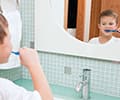In the same way dental professionals recommend brushing with fluoride toothpaste, fluoride mouthrinse, also known as mouthwash, can help strengthen tooth enamel and provide an extra level of protection for children and adults. Ask your dental professional if you or a family member six years or older would benefit by adding a fluoride mouthrinse to your oral home care regimen.
What Is Fluoride Mouthrinse?
Fluoride mouthrinse is a solution that contains fluoride, a naturally found mineral that is known to strengthen enamel and reduce cavities in children and adults. According to the American Dental Association (ADA), fluoride not only fortifies tooth enamel against acid attacks, but it also repairs the early stages of tooth decay. Plaque contains acids which cause teeth to lose minerals and can result in cavities over time. Diets high in sugar increase this amount of acid.
When the fluoride rinse reaches your teeth, the fluoride is absorbed into the enamel and remineralizes and replenishes the lost calcium and phosphorus that keep your teeth strong. Fluoride mouthwash is available both over the counter (OTC) and as a prescription, and the most common formula for daily use is made up of sodium fluoride.
Who Should Use a Fluoride Mouthrinse?
Fluoride mouthwashes are safe and effective for daily use by anyone looking for additional protection for their smile, but they could be especially beneficial for people with a high risk of tooth decay. Children under the age of six years old should not use a fluoride rinse because of risk of ingestion, and children under the age of 12 years old should be closely supervised during use. Several conditions or circumstances might make you more susceptible to tooth decay, so if you experience any of the following, you might consider speaking to your dentist about adding a fluoride mouthwash to your oral hygiene routine.
Dry Mouth
Saliva is your natural tooth-cleaner between brushing sessions because it washes food particles off your teeth and neutralizes decay-causing acids produced by bacteria. It also contains calcium, phosphorus and other important components which help to remineralize your teeth daily. When you are dehydrated or your mouth becomes parched, it puts you at higher risk for tooth decay. Dry mouth can be caused by many medications or medical conditions, and research shows that around 22 percent of the population experiences dry mouth with higher rates among the elderly. Adding a fluoride rinse to your routine can help keep your teeth clean during the day, helping prevent decay, keeping your mouth moist and protecting your teeth.
Gum Recession
When plaque forms around your gums, they can become irritated and bleed easily. They also can begin to recede, exposing some of the tooth's root surface. Because this root surface is not as strong as enamel, you are more susceptible to root decay. Treating gum disease also reduces inflammation, which may cause the gums to shrink and leave root surfaces partially exposed. Other patients who do not have gum disease may have exposed roots from brushing their teeth and gums too hard, so remember to always use a soft bristled toothbrush. Depending on the severity of the gum recession, your dentist may recommend multiple forms of fluoride protection, including OTC or prescription fluoride rinse.
Orthodontic Braces
Metal braces create many places for food and bacteria to hide, increasing your risk for cavities. A combination of plaque and sugars can lead to areas of decalcification, which yield visible chalky white spots when braces are removed that are not aesthetically pleasing . These spots may or may not eventually turn into full-fledged tooth decay. Sometimes orthodontists prescribe a fluoride mouthrinse to limit decalcification or white spot lesions.
Fillings, Crowns and Bridges
If you have a history of cavities, your dentist may suggest extra protection by using a fluoride mouthrinse after each filling. Extensive dental work, such as crowns and bridges, provide perfect hiding spots for bacteria to begin the decay process. With the regular use of fluoride, the process may be arrested before decay begins to show and the tooth can repair itself. A fluoride rinse provides additional protection beyond twice-a-day brushing.
How to Use a Fluoride Mouthrinse
When using a prescription fluoride mouthwash, always use as directed, including the dose, frequency and amount of time in mouth.
For over-the-counter products, be sure to read the directions on the label. Some manufacturers recommend using the product either before or after brushing to maximize effectiveness. To take advantage of the benefits of fluoride, swish the rinse according to the directions for use at bedtime for best results.
Fluoride mouthrinse can benefit someone who is especially prone to tooth decay, but it's important to remember that it's only one tool in your oral hygiene toolkit. Combine the use of fluoride mouthwash with brushing twice a day and flossing once per day to help prevent decay and plaque build-up and keep your smile a healthy one.
Oral Care Center articles are reviewed by an oral health medical professional. This information is for educational purposes only. This content is not intended to be a substitute for professional medical advice, diagnosis or treatment. Always seek the advice of your dentist, physician or other qualified healthcare provider.
ORAL HEALTH QUIZ
What's behind your smile?
Take our Oral Health assessment to get the most from your oral care routine
ORAL HEALTH QUIZ
What's behind your smile?
Take our Oral Health assessment to get the most from your oral care routine
Join Us
Get the best of your oral health routine and take it to the next level with expert advice, recommendations, products and solutions and special offers.
Join Us
Get the best of your oral health routine and take it to the next level with expert advice, recommendations, products and solutions and special offers.















